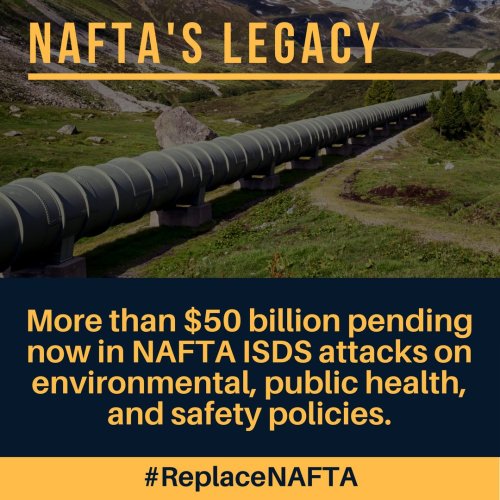Global Trade Mag | 26 May 2017
NAFTA’s Chapter 11 : Sure to be a sticking point in upcoming trade negotiations
On May 18, United States Trade Representative Robert Lighthizer gave Congress the official 90-day notice of the government’s intent to renegotiate the terms of the North American Free Trade Agreement (NAFTA). The notification was the formalization of what the new US administration had been promising since last year’s election campaign. The question on the minds of many is what specific aspects of the agreement are likely to be discussed.
The US has already signaled its own areas of interest for Canada – softwood lumber, dairy and poultry, among others. For Mexico, there’s likely to be a strong focus on procurement provisions and rules-of-origin requirements with an aim of limiting the volume of manufactured goods entering the US via its southern border.
Though it was not specifically called out in Lighthizer’s notice to Congress, one of the most overlooked aspects of NAFTA is one that struck at the heart of the opposition to the Trans-Pacific Partnership and the recently ratified Comprehensive and Economic Trade Agreement (CETA) signed by Canada and the EU, and has been a bone of contention for some years, namely the Investor-State Dispute Settlement.
Opponents of ISDS claim the settlement process lacks transparency and effectively allows private corporations to sue governments for enacting laws and regulations that adversely affect the corporation’s profitability, even if those laws and regulations serve a greater social good. Proponents, however, argue an investor-dispute mechanism must be in place to protect the interests of corporations from harmful government interference in the market, which can oftentimes favor national investors over foreign ones.
According to a recent report by the Canadian Centre for Policy Alternatives, between 1994 and 2015, there were 20 ISDS actions brought against the United States, 35 against Canada and 22 against Mexico, resulting in the payout of $376 million ($172 million from Canada and $204 million from Mexico) in damages, leaving Canada with the distinction of being the most sued country in the developed world. Meanwhile, none of the actions brought against the US have resulted in the US government being forced to dole out damages.
Given this breakdown, the ISDS is likely to be a point of contention among all three parties. US Commerce Secretary Wilbur Ross has been cited as claiming ISDS tribunals are unbalanced. Canada and Mexico, which have been forced to pay out significant penalties to private (mostly US corporations), have their own obvious reasons for wanting to see the ISDS mechanism revisited. Canadian negotiators are likely to point to some of the modifications to the ISDS included in CETA, many of which are found in Canada’s existing investment promotion and protection agreement, as noted in a recent report by the C.D. Howe Institute. These include :
- Information about claims must be submitted early on in an effort to come to an early and amicable resolution
- Like NAFTA, there’s a three-year time cap on state exposure to investor claims ; however, under CETA, there’s an opportunity for investors to extend this by two years if they have made an effort to resolve their dispute via local courts first before resorting to the ISDS
- A clause to provide early determinations by the state of disputes that lack merit, so that public funds aren’t spent needlessly on disputes that are unlikely to go anywhere.
- A limitation on damages so that investors can only be awarded damages incurred, but not punitive damages.
- Language that limits the possibility that states can be forced to change laws or regulations.
Opponents of the ISDS say the CETA modifications don’t go quite far enough, noting the limited pool of arbitrators still leaves open the possibility of conflict of interest. Others point out the modifications to the ISDS actually create more of an Investment Court System (ICS), but that it may not come into effect for years. That’s because CETA’s current ratification is provisional, meaning that while the vast majority of the agreement may come into effect fairly imminently, certain aspects, like ISDS, won’t come into effect until the deal is ratified by all EU member states.
But some also concede the CETA changes are a step in the right direction and at the very least serve as a foundation for discussion of potential ISDS reforms. Indeed, the very existence of NAFTA’s Chapter 11 in which the ISDS mechanism is contained, is one of the key aspects of the agreement that critics call out as outdated and in need of either reform or elimination.
The question, however, is what would replace Chapter 11, if anything ? Investors and activist groups will be keeping a watchful eye over negotiations and making every effort to influence discussions over any investor-dispute mechanism in their favor.
Canadian and Mexican negotiators will likely be looking for ways to satisfy the interests of the American investment community without compromising their sovereignty while also finding the means to curtail the volume of actions taken against them.
Whatever the outcome, it is likely to have an impact on the degree to which industries from each nation make investments in the others, affecting economic growth, employment, innovation and a host of other socioeconomic factors.
While the investor-state dispute mechanism may not stir up the same level of emotional reaction as labor rights, industry protectionism and offshoring, it will have a profound effect on the degree to which a new NAFTA will be leveraged by industry players. Those with a vested interest in North American trade will want to keep a watchful eye.
Cora Di Pietro is vice president of Global Trade Consulting at trade-services firm Livingston International. She is a frequent speaker and lecturer at industry and academic events and is an active member of numerous industry groups and associations.



